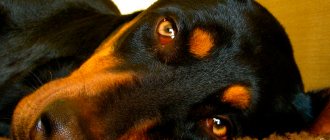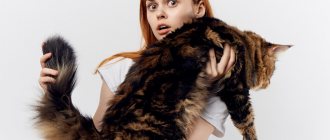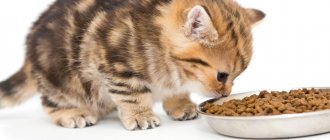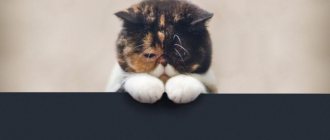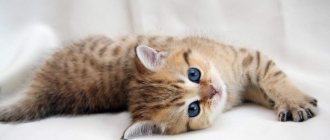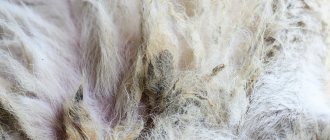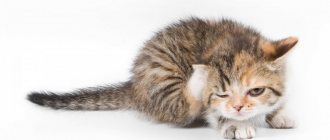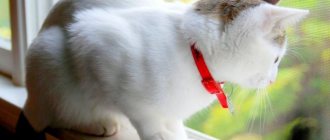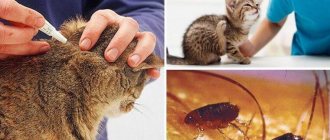Currently, pet stores have a large selection of products for getting rid of insects from adult cats. But how to remove fleas from a kitten? This task is not easy, since it is not recommended to treat babies with traditional medications intended for adult animals. The kitten is constantly licked by the mother, and the medicine, entering the cat’s esophagus, then ends up in her milk, which can cause much more harm to the baby than fleas.
In this regard, there are differences in the methods of removing fleas from newborn kittens and those whose age is 1 month or more.
Signs of fleas
Symptoms of parasites:
- Scratching and biting fur. On the skin of the animal you can find insect bites and wounds that the pet inflicted on itself when combing. Allergic reactions to flea bites are possible.
- Loss of appetite.
- Restless sleep. Fleas on a kitten interfere with your pet's sleep: during sleep, he often turns over from one side to the other, twitches his paws or jumps.
- Signs of exhaustion. Insects feed on the pet's blood, leading it to exhaustion.
The presence of parasites can also be detected by examining the animal.
What do fleas look like and why are they dangerous?
Fleas are insects that parasitize animals. They look repulsive: small (up to 2–3 mm), with flattened bodies, chitinous cover with a brownish tint. It's not easy to see them, and even harder to catch them. When trying to touch them, these ectoparasites (living on the surface of the human or animal body) exhibit amazing jumping ability. Moreover, they can live on any inhabitant of the apartment, not just on a cat. Fleas take root on dogs, rabbits, decorative rodents, and can even bite humans. Once in a home, they jump to other residents of the house and multiply.
Fleas bring a lot of inconvenience to a pet, and can infect the owner with unpleasant diseases.
Fleas themselves cause a lot of trouble. The main problem is itching and irritation of the skin at the site of the bite. But the danger of fleas lies in the fact that they are carriers of dangerous infections (anthrax, encephalitis, hepatitis, plague, etc.), as well as helminths. The appearance of fleas in a kitten leads to infection with worms.
How to remove fleas from a kitten
If a newborn kitten has become infected from its mother cat, it cannot be treated with special medications. Some of these funds remain on the wool. While licking a baby, a cat can become poisoned or pass the substance to the kitten through milk. Let's look at how to remove fleas from small kittens without harming the health of the animals:
- Combing. This method is considered the safest. To carry out the procedure, you need to prepare a bowl of water and a brush with soft bristles (you can use an old toothbrush that is no longer used). They pick up the animal and begin to comb it against the grain. Any insects caught in the brush should be drowned in a basin to prevent them from returning to the animal's fur.
- Bathing. Contact with water can cause stress. Bathing is used in cases where brushing does not help. Water not hotter than 40ºC is poured into the basin. The kitten's ears are plugged with cotton wool, placed in a basin, doused with water and soaped. Only the muzzle should be left dry. The foam should be washed off and the pet should be wrapped in a dry, clean napkin.
During bathing, most insects will die from soap and water. The rest of the parasites will try to escape on the pet's face. For this reason, after washing the animal, the face should be combed with a brush.
When not to use chemicals
The use of specialized preparations containing insecticides is permitted only for kittens that have already been weaned. This is due to the fact that the cat instinctively constantly licks its offspring, which leads to the ingestion of a toxic substance and subsequently severe poisoning and even death.
Until two weeks of age, no methods of handling a small animal, even bathing, are allowed. The baby has a weak immune system, so toxic exposure causes poisoning and death of the kitten.
Flea control products
You should start treating your pet for parasites using special means when he is 1 month old. Before you think about how to get rid of fleas, the kitten must be separated from the cat.
When purchasing insect repellents, you need to pay attention to age restrictions. The composition may contain pyrethroids (alphamethrin, cypermethrin) or organophosphorus insecticides (dichlorvos, malathion). For adult individuals, these components do not pose a danger. However, they are contraindicated for cubs under six months of age.
Insect repellents should be used carefully. The owner must ensure that they do not get into the animal’s eyes, nose or mouth. If this happens, your pet may experience vomiting, nasal or eye discharge, drooling, shortness of breath, and other signs of intoxication. In this case, the pet needs to be given water or milk. Minor poisoning does not pose a danger to life, but it is advisable to take the kitten to the veterinarian.
Shampoos
If the animal is already 4 weeks old, you can eradicate the parasites using shampoo. It is recommended to use such products as “Mr. Kiss" and "Phytoelite". For the first bath, use no more than 0.5 ml of shampoo, which is dissolved in 0.4-0.5 liters of warm water. The product should remain on the pet's fur for at least 5 minutes. Then it should be washed off with warm, clean water.
It is necessary to observe the kitten’s reaction to the selected shampoo for 2 weeks. If the allergy does not manifest itself, the dose of the drug is increased by 2 times. If you have an allergic reaction, you can try a different shampoo.
Sprays
When using sprays (Hartz, Frontline), owners do not have a question about at what age their pet’s fur is treated with this type of product. Both adults and young animals from 6 months of age can be treated for parasites using a spray. It is not advisable to use the product more than once a week.
If the animal reacts inadequately to the procedure, the substance can be applied using a cotton swab. The same method is always used for processing the head. It is necessary to use a swab to avoid getting the product into the kitten's eyes, mouth, nose and ears.
Flea collar
A flea collar (“Hartz”, “Bolfo”) should be used only after the animal has been rid of insects. This product is intended to protect against parasites, not to fight them. It is permissible to put a collar on an animal when it reaches the age of 2 months. You should buy a model designed for a baby, not an adult.
Kittens often react negatively to the collar. You should not force your animal to wear it all the time. It is enough to use the collar while walking outside, where the pet can come into contact with other animals. It is recommended to put a collar on your kitten before being away from home for a long time, for example before going to the country for the weekend. A few days before departure, it is advisable to treat the animal’s fur with a spray.
Rules for bathing kittens
It is worth remembering that not all drugs are approved for use. Initially, the shampoo is diluted with water, and the pet’s fur is lathered with this solution. The pet should remain in this state for several minutes (see instructions). After the time has passed, the kitten should be washed with warm, but not hot water and dried. At the end of the procedure, the pet should be combed with a fine comb, which will help to finally get rid of the insects.
Choosing a specialized shampoo
When choosing a shampoo, you should consider the following characteristics of a kitten:
- Age of the kitten. Newborns are recommended a specialized product that will not damage their skin.
- The intended purpose is that if the infection is severe, then insecticides are used, and the preventive measure implies a gentle composition.
- Depending on the pet's condition - with a weakened body, anemia, pregnancy, only a gentle composition.
- Features of wool - shampoos for both long-haired and sphinxes.
- Storage period.
To correctly resolve issues related to the health of your pets, we recommend contacting a veterinary clinic.
Let's name the main brands of shampoos:
- Leopard. Used for newborns as a prophylaxis.
- BioVax. Used as a preventive measure for babies from 1 month of age. Also suitable for sick and weakened animals.
- Celandine. Used as treatment and prevention from the age of two months.
- Lugovoy. Used as treatment and prevention from 12 weeks of age.
The remaining shampoos are used for kittens from 4 months of age.
Folk remedies for fleas
You can fight parasites using folk remedies such as:
- Lemon. It is necessary to finely chop the fruit, pour 1 cup of boiling water over it and leave for 24 hours. Then the product is sprayed onto the kitten’s fur.
- Tansy. 1 tbsp. l. plants, pour 0.5 liters of boiling water, leave for several hours and apply to the animal’s fur using a cotton swab.
- Essential oils. To get rid of parasites and prevent fleas, rosemary, mint, cedar or lavender oils are suitable. A few drops of the product are added to a glass of boiled water. After a few minutes, the mixture can be sprayed onto the animal. You can also lubricate your fingertips with oil and give the kitten a light massage.
- Garlic. It is necessary to chop a small head of garlic and pour 1 liter of boiling water into the resulting pulp. The liquid is infused for 10-12 hours, after which it can be used to treat the pet’s fur.
- Geranium. 5-6 tbsp. l. crushed leaves of a houseplant pour 3 liters of boiling water or hot water. The liquid is infused for 30-40 minutes. During this time, it will have time to cool down to a comfortable temperature for the kitten. It is necessary to bathe your pet in water with geranium without soap or shampoo.
What exactly is more effective: a collar or drops?
To understand the difference between flea drops and a flea collar, you need to understand that the drops are solutions for killing fleas. They may differ in chemical composition and degree of action. Another feature of droplets is the fact that parasites can adapt to some of their types. Therefore, they need to be changed after some time.
Collar
Important! Collars do not destroy parasites, but only repel them with their smell. Therefore, to achieve the greatest effect in the fight against parasites, it is best to combine two methods. First, you will need to treat the pet's fur with drops, and then put on a collar for preventive purposes.
Preventing flea infestation
In order not to think about the age at which you can poison fleas on a kitten, you need to prevent infection with parasites. Owners of kittens should prevent their pets from coming into contact with stray animals. Upholstered furniture in the apartment must be vacuumed regularly. The places where the kitten spends the most time (sofa, armchair, rug in the hallway) should be vacuumed 2-3 times a week. At least 4-5 times a month you need to treat your pet's sleeping place.
Fleas can enter an apartment on people's clothes or shoes, or on the fur of other pets.
For preventive purposes, you should inspect your pet’s fur at least once every 2 weeks. If there are other animals in the apartment, they also need to be examined.
All information posted on the site is provided in accordance with the User Agreement and is not a direct instruction to action. We strongly recommend that before using any product, you must obtain a face-to-face consultation at an accredited veterinary clinic.
What to choose depending on the baby’s age
Treatment is carried out according to the age of the kitten. A newborn is more gentle to chemicals than a six-month-old baby. Therefore, experts always prescribe the dosage for a specific age on the packaging.
1 month
Age requires additional protection. Especially if the kitten was separated from its mother. Scratching is suitable for a newborn, and can also be washed with a gentle product. It is better to choose a natural shampoo that will help protect the kitten from insects and minimize the onslaught of fleas.
1.5 months
At this age, you can use all the methods as for a newborn. Additionally, there are sprays on the market that can be applied from 1.5 months of age.
They can only be purchased at a veterinary clinic. The hardware department of some shopping centers also offers a wide selection of flea baiting chemicals.
2 months
An infectious kitten at 2 months can already use specialized drops in addition to sprays, shampoo and combing. They can be purchased at veterinary pharmacies without a prescription.
Important! You should not wash your kitten for 4-5 months after applying the product. If this cannot be avoided, the drops are reapplied. The drops must be used strictly according to the instructions.
3 months
At 3 months, you can use all the means discussed earlier - shampoos, sprays and drops, combing (although kittens at this age can already do this on their own).
Important! Only a veterinarian or a breeder at his own discretion can determine which method is best to use. The main thing is to choose a drug based on age and weight.
We create conditions so that the kitten does not get sick
To avoid infection, the breeder has the right to take preventive measures. Basic tips:
- daily examination of your pet for the presence of parasites;
- use of insecticides;
- frequency in the house;
- limited contact with non-domestic pets.
If it was not possible to avoid infection, then drastic measures must be taken to ensure a speedy recovery of the pet.
Soaping the composition
Soaping the composition is a complex process and you can’t do it without an assistant. Cats rarely like to take baths, so you need to hold your pet and thoroughly rub in the shampoo, avoiding the area around the eyes and face.
Carefully distribute the required dose over the entire body, including the abdomen, allow it to be absorbed, and then rinse off. Under no circumstances should you allow your cat to lick you for 10 minutes.
To avoid getting the product into your ears, you must first plug them with cotton tubes, which should be moistened with vegetable oil. It is necessary to rinse the kitten's fur thoroughly so that no chemicals remain.
How to dry your pet's fur
Drying a kitten after taking a bath is an important operation that preserves its health, because the body of babies is not protected from the effects of the sun and cold, as well as drafts. One drying method is to use a hair dryer. But you need to do this wisely. You can’t point it at the muzzle; you need to turn on the medium mode.
If the cat is afraid of the sound made, then you need to purchase a quieter device or use a heater-wind blower. The cats always move closer to him and are not afraid of him.
After taking a bath you should not:
- Remove the towel and immediately allow the cat to dry itself.
- Lock the animal in a cold room with an open window.
- Screaming while bathing and drying.
- Keep in a wet towel for a long time.
- Leaving the cat wet.
After blow-drying, comb the kitten and then reward it with a treat.
What to do if a kitten is poisoned by a drug
First provide first aid. Then go to the veterinary clinic and explain everything to the staff. Unlike an adult, a kitten’s infection develops quickly and the consequences can be more serious.
Regardless of what poisoned the kitten, you need to provide first aid. To reduce the concentration of the substance that caused the poisoning, it is worth giving the kitten water. If he refuses water, you need to pour it through a pipette.
If the substance gets through the fur, immediately bathe the pet. In case of chemicals that have got inside, you need to give 2 tablets of activated carbon and take the kitten to a veterinary clinic. Explain the cause of poisoning to provide effective assistance to your pet.
